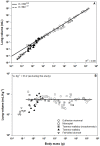Phase contrast imaging reveals low lung volumes and surface areas in the developing marsupial
- PMID: 23349744
- PMCID: PMC3548826
- DOI: 10.1371/journal.pone.0053805
Phase contrast imaging reveals low lung volumes and surface areas in the developing marsupial
Abstract
Marsupials are born with immature lungs when compared to eutherian mammals and rely, to various extents, on cutaneous gas exchange in order to meet metabolic requirements. Indeed, the fat-tailed dunnart is born with lungs in the canalicular stage of development and relies almost entirely on the skin for gas exchange at birth; consequently undergoing the majority of lung development in air. Plane radiographs and computed tomography data sets were acquired using phase contrast imaging with a synchrotron radiation source for two marsupial species, the fat-tailed dunnart and the larger tammar wallaby, during the first weeks of postnatal life. Phase contrast imaging revealed that only two lung sacs contain air after the first hour of life in the fat-tailed dunnart. While the lung of the tammar wallaby was comparatively more developed, both species demonstrated massive increases in air sac number and architectural complexity during the postnatal period. In addition, both the tammar wallaby and fat-tailed dunnart had lower lung volumes and parenchymal surface areas than were expected from morphometrically determined allometric equations relating these variables to body mass during the neonatal period. However, lung volume is predicted to scale with mass as expected after the neonatal marsupial reaches a body mass of ∼1 g and no longer relies on the skin for gas exchange. Decreased lung volume in the marsupial neonate further supports the maxim that cutaneous gas exchange occurs in the marsupial neonate because the respiratory apparatus is not yet capable of meeting the gas exchange requirements of the newborn.
Conflict of interest statement
Figures





Similar articles
-
Development of the terminal air spaces in the gray short-tailed opossum (Monodelphis domestica)- 3D reconstruction by microcomputed tomography.PLoS One. 2024 Feb 16;19(2):e0292482. doi: 10.1371/journal.pone.0292482. eCollection 2024. PLoS One. 2024. PMID: 38363783 Free PMC article.
-
Morphometric analysis of postnatal lung development in a marsupial: transmission electron microscopy.Respir Physiol. 1999 Oct 15;118(1):61-75. doi: 10.1016/s0034-5687(99)00068-7. Respir Physiol. 1999. PMID: 10568420
-
Structural and functional development of the respiratory system in a newborn marsupial with cutaneous gas exchange.Physiol Biochem Zool. 2011 Nov-Dec;84(6):634-49. doi: 10.1086/662557. Epub 2011 Oct 14. Physiol Biochem Zool. 2011. PMID: 22030856
-
The tammar wallaby: A marsupial model to examine the timed delivery and role of bioactives in milk.Gen Comp Endocrinol. 2017 Apr 1;244:164-177. doi: 10.1016/j.ygcen.2016.08.007. Epub 2016 Aug 12. Gen Comp Endocrinol. 2017. PMID: 27528357 Free PMC article. Review.
-
The tammar wallaby: a non-traditional animal model to study growth axis maturation.Reprod Fertil Dev. 2019 Jul;31(7):1276-1288. doi: 10.1071/RD18271. Reprod Fertil Dev. 2019. PMID: 31030727 Review.
Cited by
-
3D reconstruction of the bronchial tree of the Gray short-tailed opossum (Monodelphis domestica) in the postnatal period.J Anat. 2023 Dec;243(6):910-935. doi: 10.1111/joa.13928. Epub 2023 Jul 27. J Anat. 2023. PMID: 37497834 Free PMC article.
-
Development of the pulmonary vasculature in the gray short-tailed opossum (Monodelphis domestica)-3D reconstruction by microcomputed tomography.Anat Rec (Hoboken). 2025 Apr;308(4):1144-1163. doi: 10.1002/ar.25542. Epub 2024 Jul 12. Anat Rec (Hoboken). 2025. PMID: 38993078 Free PMC article.
-
In-line phase contrast imaging of hepatic portal vein embolization with radiolucent embolic agents in mice: a preliminary study.PLoS One. 2013 Dec 4;8(12):e80919. doi: 10.1371/journal.pone.0080919. eCollection 2013. PLoS One. 2013. PMID: 24324646 Free PMC article.
-
Development of the terminal air spaces in the gray short-tailed opossum (Monodelphis domestica)- 3D reconstruction by microcomputed tomography.PLoS One. 2024 Feb 16;19(2):e0292482. doi: 10.1371/journal.pone.0292482. eCollection 2024. PLoS One. 2024. PMID: 38363783 Free PMC article.
References
-
- Simpson SJ, Flecknoe SJ, Clugston RD, Greer JJ, Hooper SB, et al. (2011) Structural and functional development of the respiratory system in a newborn marsupial with cutaneous gas exchange. Physiological and biochemical zoology : PBZ 84: 634–649. - PubMed
-
- Runciman SIC, Baudinette RV, Gannon BJ (1996) Postnatal development of the lung parenchyma in a Marsupial: The Tammar Wallaby. Anatomical Record 244: 193–206. - PubMed
-
- Miller NJ, Orgeig S, Daniels CB, Baudinette RV (2001) Postnatal development and control of the pulmonary surfactant system in the tammar wallaby Macropus eugenii. Journal of Experimental Biology 204: 4031–4042. - PubMed
-
- Ribbons KA, Baudinette RV, McMurchie EJ (1989) The development of pulmonary surfactant lipids in a neonatal marsupial and the rat. Respiration Physiology 75: 1–10. - PubMed
Publication types
MeSH terms
LinkOut - more resources
Full Text Sources
Other Literature Sources
Medical

